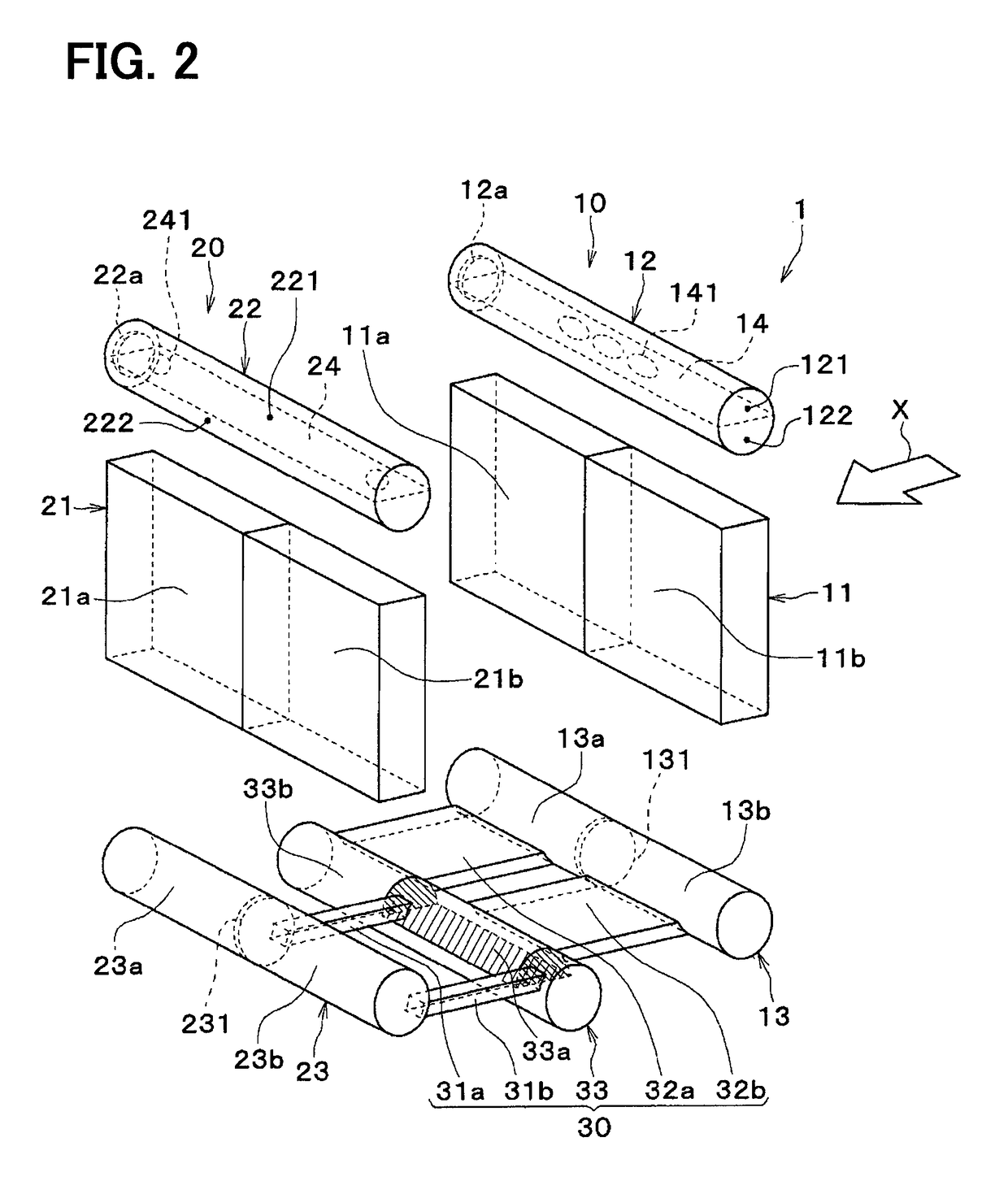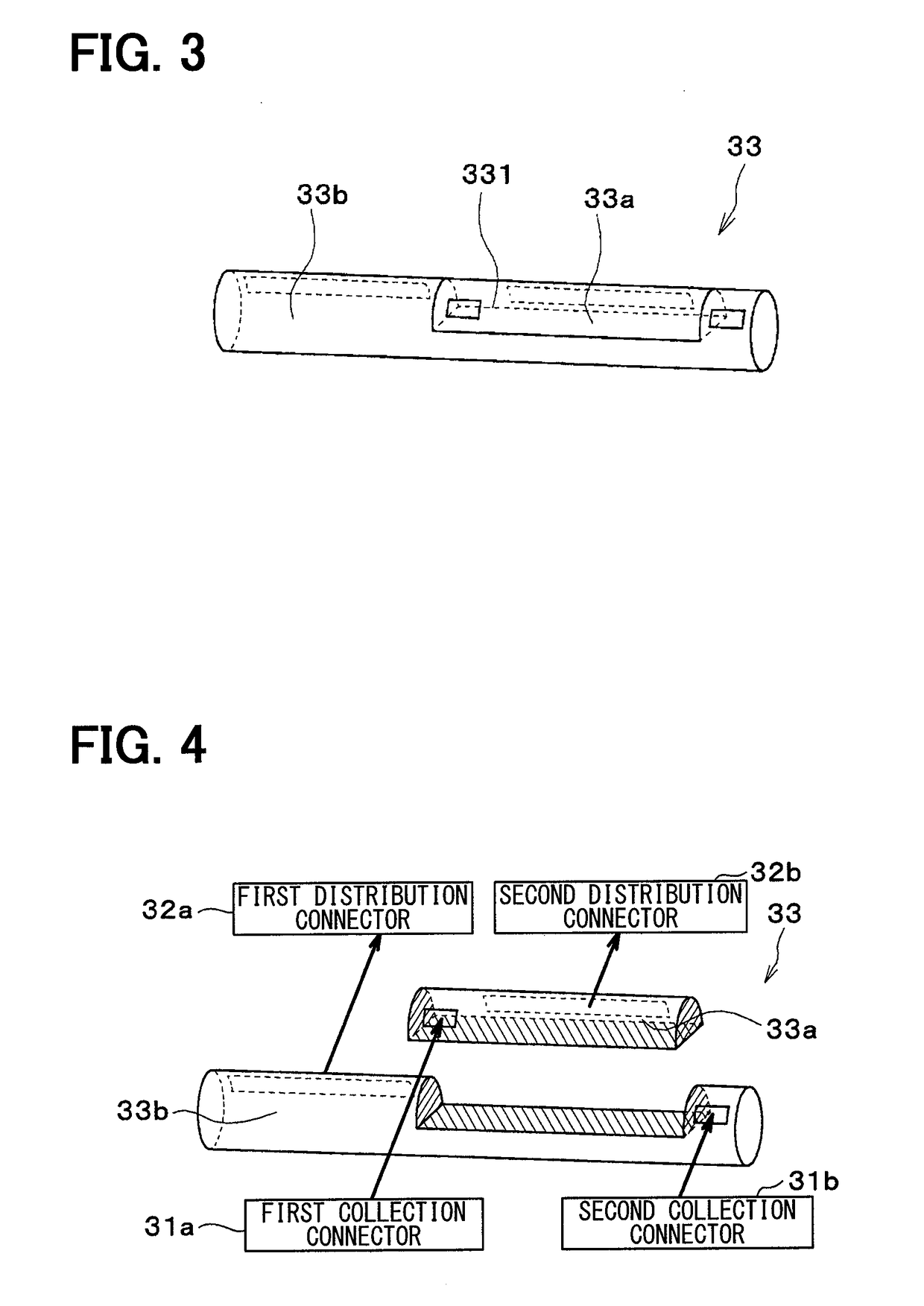Refrigerant evaporator
a technology of refrigerant evaporator and liquid phase, which is applied in the direction of indirect heat exchangers, refrigeration components, lighting and heating apparatus, etc., can solve the problems of deteriorating distribution of refrigerant, and achieve the effect of enhancing the distribution of liquid phase refrigerant in the heat-exchanging core portions
- Summary
- Abstract
- Description
- Claims
- Application Information
AI Technical Summary
Benefits of technology
Problems solved by technology
Method used
Image
Examples
first embodiment
[0053]A first embodiment will be described using FIG. 1 through FIG. 7. A refrigerant evaporator 1 of the present embodiment is a cooling heat exchanger which is applied to a vapor compression refrigerating cycle in an air conditioner for a vehicle to adjust a temperature in the vehicle interior and cools blown air to be blown into the vehicle interior by absorbing heat from the blown air and letting refrigerant (liquid phase refrigerant) evaporate. In the present embodiment, the blown air corresponds to “a fluid flowing outside to be cooled”.
[0054]The refrigerating cycle is known to include the refrigerant evaporator 1 as well as components unillustrated herein, such as a compressor, a radiator (condenser), and an expansion valve. In the present embodiment, the refrigerating cycle is formed as a receiver cycle in which a liquid receiver is disposed between the radiator and the expansion valve. The refrigerant in the refrigeration cycle is mixed with refrigerant oil to supply lubric...
second embodiment
[0122]A second embodiment will be described with reference to FIG. 8. The second embodiment is different from the first embodiment above in a configuration of first communication holes 241 and second communication holes 141.
[0123]As shown in FIG. 8, first communication holes 241a, which are a part of multiple first communication holes 241, are disposed at positions so as to overlap the second communication holes 141 when viewed in a flow direction X of blown air. First communication holes 241b, which are the rest of the multiple first communication holes 241, are disposed at positions so as not to overlap the second communication holes 141 when viewed in the flow direction X of blown air.
[0124]Second communication holes 141a, which are a part of the multiple second communication holes 141, are disposed at positions so as to overlap the first communication holes 241 when viewed in the flow direction X of blown air. A second communication hole 141b, which is a remaining of the multipl...
third embodiment
[0129]A third embodiment will now be described using FIG. 12 through FIG. 18.
[0130]In FIG. 13, tubes 111, 211 and fins 112, 212 of respective heat-exchanging core portions 11, 21 described below are omitted.
[0131]As shown in FIG. 14, a dam plate 524 is provided inside a first leeward tank portion 22. The dam plate 524 serves as a dam portion that holds back a flow of a liquid phase refrigerant that has flowed into the first leeward tank portion 22 from a refrigerant inlet portion 22a.
[0132]As shown in FIG. 15, the dam plate 524 is formed in substantially a disc shape and an outer peripheral surface is bonded to an inner peripheral surface of the first leeward tank portion 22. The dam plate 524 has a through-hole 5241 penetrating from one side to the other side. The through-hole 5241 is disposed on a slightly upper side of a center portion of the dam plate 524 in a vertical direction (opposite side to the leeward heat-exchanging core portion 21 in a tube longitudinal direction).
[013...
PUM
 Login to View More
Login to View More Abstract
Description
Claims
Application Information
 Login to View More
Login to View More - R&D
- Intellectual Property
- Life Sciences
- Materials
- Tech Scout
- Unparalleled Data Quality
- Higher Quality Content
- 60% Fewer Hallucinations
Browse by: Latest US Patents, China's latest patents, Technical Efficacy Thesaurus, Application Domain, Technology Topic, Popular Technical Reports.
© 2025 PatSnap. All rights reserved.Legal|Privacy policy|Modern Slavery Act Transparency Statement|Sitemap|About US| Contact US: help@patsnap.com



